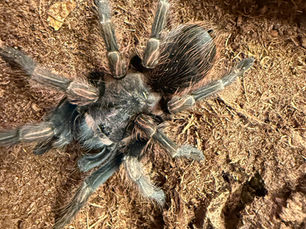top of page
All Posts


Lasiodora
The Lasiodora genus includes a relatively modest number of species, all of which are found in Brazil. Many species that were originially classified as Lasiodora have been reclassified into other genera. The current list of Lasiodora includes large size species. The most recent taxonomic revision and analysis of this genus was publihsed by Bertani in 2023. Several species have been reclassified, in synonymy, or nomina dubia. The accepted species are: Lasiodora benedeni (ex dif


Lasiodorides
The Lasiodorides genus is limited to two species, primarily from Peru. Sherwood 2021 redescribed the Lasiodorides genus. Genus and species: Lasiodorides polycuspulatus Common name: Peruvian Blonde Given name: Latte L. polycuspulatus is a slow growing and generally docile species from northeastern Peru. Females reach an adult size of 5 to 6 inches. They are common in the hobby given their disposition and lack of aggressiveness. Habitat: Creates burrows around and under rocks a


Vitalius
The genus Vitalius includes a moderate number (n = 11 accepted) of South American species, typically from Brazil and less so from Argentina. Few species are available in the hobby. Genus and species: Vitalius chromatus Common name: Brazilian red and white Given name: Twix This species was considered a Lasiodora, then a Nhandu, and now a Vitalius. Source: Peters 2005 Husbandry Notes: Enclosure: 12x12x12 Sex: Male Life stage: Mature Size: Approximately 6 inches but mostly legs


Xenesthis
The Xenesthis genus contains relatively few species, but of their species, they tend to exhibit vibrant coloration. This species hails from Columbia and Venezuela. Five Xenesthis species are currently accepted by scientific classifications. This genus is summarized by Sherwood 2023. Genus and species: Xenesthis sp. white Common name: Columbian Lesser White Given name: Zoe This species... Husbandry Notes: Enclosure: 12x12x12 Sex: Female Life stage: sub-adult Size: Approximatel


Phormictopus
The Phormictopus genus are found in the Greater Antilles, including the West Indies, Dominican Republic, Haiti, and Cuba. The various Phormictopus species are relatively large. This genus includes some very bold and brilliant specimens that make great display tarantulas. Currently, there are approximately 12 to 14 species in this genus with a handful of species in synonymy. The taxonomy for this genera is confusing with inconsistent classifications. There are some color varia


Brachypelma
The Brachypelma genus is a mid-size tarantula, with bright orange and red colorations among many of its species. They can be found in Mexico. This is a very popular genus among hobbyists and because of this, many species have been captured and exported illegally from Mexico. Thus, all species are protected and regulated under Convention on International Trade of Endangered Species (CITES). These are generally slow growing species. The most recent and information publication o


Acanthoscurria
The Acanthoscurria genus is found throughout South America, spanning several countries. Some species have been identified in the West Indies. This genus includes 19 accepted species with several in synonymy and nomina dubia. The most common species in the hobby is A. geniculata (Brazilian whiteknee). Genus and species: Acanthoscurria sp. maldonadoensis (undescribed, not even listed as nomina dubia) Common name: Maldonado birdeater Given name: Mahogany This species is allegedl
bottom of page